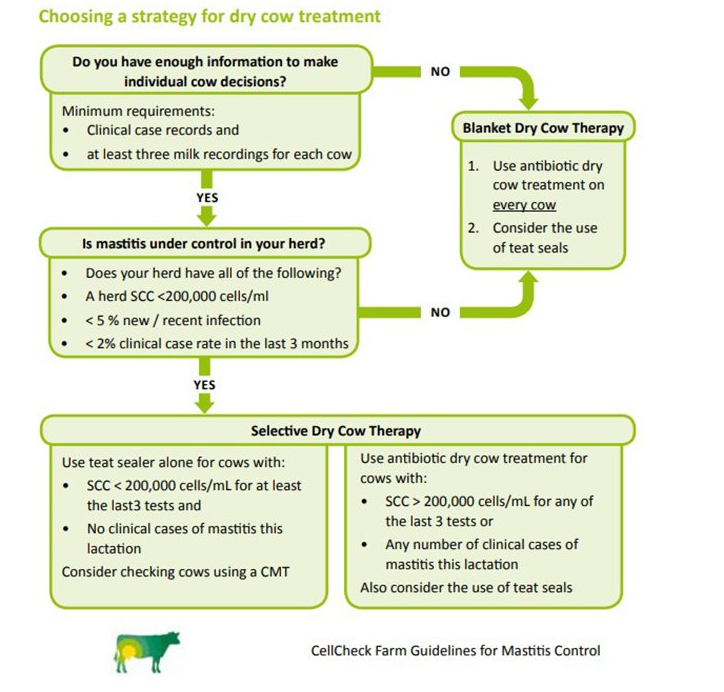- It allows for cows to build up body condition score (BCS) for calving and early lactation;
- To regenerate mammary tissue in preparation for milking again;
- To optimise the benefits of hormonal changes that occur around calving.
Selecting cows to dry off
When selecting cows for drying off it is important to identify first lactation or cows not in the desired BCS. These cows will require a longer dry period to have a chance to get in the right BCS score or recover after their first lactation. It is advised to give these cows up to a twelve week dry period. Cows that have been identified as having a high cell count, should be dried off early and treated with an antibiotic. A culture test should be completed on these cows to identify the bacteria causing the issue. The completing of a culture test also means that the antibiotic best suited to treating the problem bacteria can be used. For cows entering their third or more lactation, it is advised that these cows are given a dry period of between six to eight weeks.
Drying off procedure
Research has indicated that 50% of all clinical mastitis cases that occur in the first 100 days of the next lactation, can be attributed to the drying off process. To achieve the best results from the drying off process and avoid mastitis issues in early lactation, here are some tips:- Have the necessary equipment ready, including: a clean apron; disposable gloves; teat wipes / cotton wool; methylated spirits; marker; head torch and intramammary tubes;
- It is important not to dry off cows when you are tired, hungry, or stressed. Only dry off 20 cows at a time and have additional help available to assist. Have a system in place for cleaning, sterilising teats and tubing, and repeat for each cow;
- Ensure teats are disinfected post-tubing and clean the parlour between batches to maintain a clean environment;
- To avoid any errors, good identification of cows and accurate record-keeping are essential;
- Following dry-off, keep the cows standing for a minimum of 30 minutes in a clean yard before putting in a dry field or clean cubicles.
Selective dry cow therapy
Some farmers may be considering selective dry cow therapy with the new regulations coming into place next year. Animal Health Ireland (AHI) have outlined a strategy that can be used as a guide to determine the cows that could receive selective dry cow therapy.
Liver fluke
Dry-off is the perfect time to dose for liver fluke. Dung samples should be collected to determine if dosing is required and if so, at what rate. It is also a good opportunity to complete some hoof pairing on any cows that may require some pairing, these cows can be identified by mobility scoring or locomotion scoring.Dry period management
Unlike most spring-calving dairy cows, some autumn-calving cows will spend the majority of their dry period at grass. This has its advantages, such as less work and in general is healthier for the animal, but it also has disadvantages, such as summer mastitis. Mineral supplementation for spring calvers usually involves a dusting of silage, for autumn calvers, mineral boluses cannot replace the need for daily pre-calving minerals. So it is important that pre-calving minerals are fed to cows. Magnesium (Mg) is needed by all cows during the dry period to prevent sub-clinical and clinical cases of milk fever.The recommend rate of supplementation is 25g/cow/day.
In addition, trace minerals – copper (Cu), selenium (Se), zinc (Zn), etc. – should be fed from at least six-weeks pre-calving to achieve adequate levels for the calving period.
